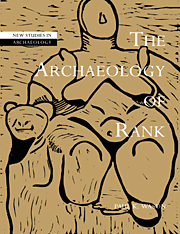Book contents
- Frontmatter
- Contents
- List of figures and tables
- Acknowledgments
- 1 The present study of past society
- 2 Social theory and social life: models of society in the archaeological study of status
- 3 Inequality and social life: a working model
- 4 Mortuary data as evidence of ranking, Part 1
- 5 Mortuary data as evidence of ranking, Part 2
- 6 The form and distribution of artifacts
- 7 Status, settlements, and structures
- 8 Çatal Hüyük: a ranked Neolithic town in Anatolia?
- Notes
- References
- Index
- NEW STUDIES IN ARCHAEOLOGY
4 - Mortuary data as evidence of ranking, Part 1
Published online by Cambridge University Press: 22 August 2009
- Frontmatter
- Contents
- List of figures and tables
- Acknowledgments
- 1 The present study of past society
- 2 Social theory and social life: models of society in the archaeological study of status
- 3 Inequality and social life: a working model
- 4 Mortuary data as evidence of ranking, Part 1
- 5 Mortuary data as evidence of ranking, Part 2
- 6 The form and distribution of artifacts
- 7 Status, settlements, and structures
- 8 Çatal Hüyük: a ranked Neolithic town in Anatolia?
- Notes
- References
- Index
- NEW STUDIES IN ARCHAEOLOGY
Summary
Whatever else it may accomplish, the central and immediate goal of burial is the proper “laying to rest” or disposal of the body of a former member of the society. But there have been widely varying ideas on what exactly constitutes “proper” treatment, actual practice being influenced by beliefs concerning death, and any of the ways a person had been of significance to others. Another obvious yet important observation is that of variation within the practice of one society. Differential treatment among contemporaries means not all mortuary traits can be fully explained apart from significant differences among people.
It has often been observed in both ethnographies and synthetic works that treatment in death is closely related to social position in life (Keswani 1989); mortuary practice is heavily influenced by social organization. It is also influenced by ideology, particularly the meaning and significance of death both for the one who died and for those who are left. It is not clear to what extent each of these factors influences burial custom, but probably very little of actual practice is affected by one and not the other. Further, many aspects of burial practice will be overtly symbolic, over and above the sense in which all products of human activity embody meaning. Using this to learn about the society, for example to understand religious beliefs, or the place of status within a world view, may require unlocking the meaning of mortuary symbolism, a difficult if potentially rewarding study.
- Type
- Chapter
- Information
- The Archaeology of Rank , pp. 67 - 86Publisher: Cambridge University PressPrint publication year: 1994



